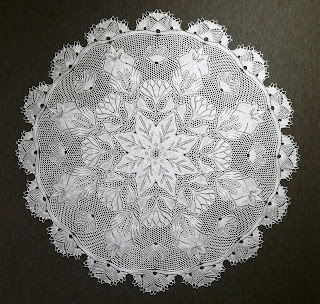Now, I am a lover of the fiber arts, and will vehemently defend their title as ARTS as well as crafts. But I was a bit surprised, a gallery of knitting? Not a museum with traditional patterns and ethnographic pieces?
We found the building (13th c. and still looking good!), and wound up narrow steps to the gallery space. What should meet my eyes but huge round mandalas of lace - Niebling Shawls pinned out on black velvet.
And what, pray tell, is a Niebling? In knitting circles the name is fairly well known, they are challenging patterns and represent a considerable investment of time and yarn. The man (yes, a man!) behind the patterns is less well known.
The variety of motifs is impressive, from common lace leaf patterns to detailed realistic shapes and geometric designs. Many of the motifs can be found in older knitting patterns, and represent a number of ethnographic sources, but some may have been invented by Niebling himself. That is, however impossible to know, as patterns were rarely written down, and the exact date of an object can be difficult to judge!
I have seen a number of Niebling shawls in person, both on the needles and on the back. Even knit in very small yarn and needles they tend to be large and impressive textiles! With a heavier yarn and appropriate gauge of needle the doilies become massive bed covers.
However, this exhibit was perhaps the finest lace work I've ever seen. These pieces are much easier to appreciate when blocked wide and seen clearly against a backdrop. Even the non-crafting Mr. Crafty was impressed by the images and designs.
And the second artistry of these is the blocking! Not only were they perfect circles with each point carefully stretched and pinned, but the sway and flow of stitches was carefully arranged. The leaves and flowers tilted carefully, while the in-between stitches were stretched or compressed to allow the entire piece to lay perfectly flat.
I'm going to take a brief moment to remind you, gentle reader, that both the master pattern maker and the skilled knitter here are not your grandmother. In fact, they are both men. So if anyone gives you any bullshit about knitting being a strictly feminine pastime, after you're done lecturing them about medieval knitting guilds, push their face in this and tell them to *redacted*
The pieces ranged from large mandalas, about 4 ft. across, to smaller doilies perhaps only 1 ft. wide.
Here we see the beginnings of a shawl, in fine estonian wool, with wine corks as stitch savers. I mentioned that this guy owned a rock club, right?
A very worthwhile experience in Tallinn! Get a beer at Hopster and then run over and drop a few euros on this gallery, it's well worth it! Even if you're not a stitching enthusiast.


















No comments:
Post a Comment